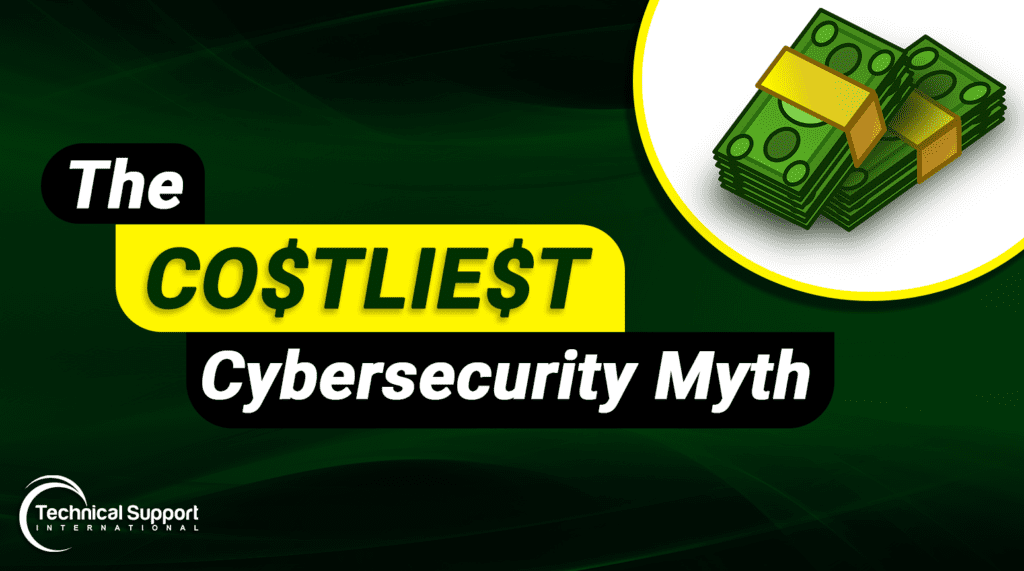Blog

The Costliest Cybersecurity Myth
Christopher Souza | CEO
The Costliest Cybersecurity Myth: “We’re Too Small to Be Attacked”
Cybersecurity is full of myths, but one of the most dangerous—and expensive—misconceptions among small and medium-sized businesses (SMBs) is the belief that they are too small to be targeted by cybercriminals. Many SMBs assume that hackers focus their efforts on large enterprises with deep pockets, but the reality is that cybercriminals are opportunistic. They exploit vulnerabilities wherever they exist, and SMBs often provide an easier entry point due to weaker security measures.
This mistaken belief leads to inadequate security investments, leaving businesses wide open to attacks that can result in devastating financial, operational, and reputational damage that is actually worse for small businesses since they’ll struggle to make up for their losses versus if a larger company with more resources got hit. Let’s help break down why this myth is wrong, the common cybersecurity misconceptions that SMBs have, and the real-world consequences of cybercrime beyond just financial losses.
Why SMBs Are Prime Cyber Targets
According to industry reports, nearly half of all cyberattacks target small and medium-sized businesses. Hackers know that these organizations often lack the resources and security expertise of larger enterprises, making them an easy mark. Additionally, SMBs frequently act as vendors or subcontractors for larger companies, making them a stepping stone for attackers looking to infiltrate enterprise networks.
Cybercriminals don’t need to steal millions from a single organization to make money—they can breach hundreds or thousands of small businesses with automated attacks like phishing, ransomware, and credential stuffing.
The Real Cost of a Cyber Attack
Many SMBs assume that even if they were attacked, the damage wouldn’t be severe. However, statistics show otherwise:
`
- 60% of small businesses shut down within six months of a cyberattack.
`
- The average cost of a data breach for SMBs is around $4.45 million.
`
- Ransomware payments can range from thousands to millions, with no guarantee of data recovery.
`
Even if an SMB survives financially, a cyber incident can result in lost customer trust, regulatory fines, noncompliance with the NIST 800-171 framework, failure to meet CMMC 2.0 certification requirements, and potential violations of SEC cybersecurity disclosure regulations, all of which can cause operational downtime that can cripple the business for months.
Common Cybersecurity Misconceptions Among SMBs
Beyond the “we’re too small” myth, there are other costly cybersecurity misconceptions that SMBs hold:
`
- “We Have Nothing Worth Stealing”
SMBs often believe they don’t have valuable data, but all businesses handle sensitive information—whether it’s customer data, payment details, or proprietary business operations. Cybercriminals can use this data for identity theft, sell it on the dark web, or leverage it in further attacks.
`
- “We Use Antivirus Software, So We’re Safe”
While antivirus software is a basic security measure, it is far from enough. Cybercriminals use sophisticated attack methods, including zero-day exploits, phishing, and social engineering, that traditional antivirus programs cannot prevent. A layered security approach is essential. These include:
`
✔️ MFA (Multi-Factor Authentication)
`
✔️ Network Security Monitoring & Alerting (SIEM)
`
✔️ End User Security Awareness Training & Phishing Simulations
`
✔️ Incident Response Planning & Management (IRP)
`
✔️ Vulnerability Management
`
For more details on these security services, check out our in-depth blog post: Cybersecurity Awareness Month: Strengthen Your Defenses with These 5 Critical Services – TSI Support
`
- “Cybersecurity is IT’s Job, Not Ours”
Cybersecurity is a business-wide responsibility, not just an IT concern. Employees are often the weakest link in security due to human error and phishing scams. In fact, 85% of all cybersecurity breaches are due to poor employee education. Training staff on cybersecurity awareness and best practices is just as crucial as having the right technology in place. We offer extensive End-User Security Awareness training that incorporates regular computer-based training (CBT) and phishing simulations. These trainings empower employees to safeguard their employer’s digital assets and stay vigilant against common cyber-threat methods that untrained employees might let slide.
“
- “We Back Up Our Data, So Ransomware Isn’t a Threat”
Regular backups are important, but many businesses fail to secure their backups properly. If ransomware spreads to backup systems, data recovery becomes impossible. Air-gapped, encrypted, and tested backups are critical for true resilience. We offer ways to understand the ransomware threat landscape and employing our advanced security solutions keeps your organization protected. Things like setting up a backup fire drill that tests your organization’s internal systems to mitigate attacks, determining your RTO (Recovery Time Objective) to determine when an asset can come back online after it goes down and your RPO (Recovery Point Objective) to figure out the acceptable amount of data a company is open to losing in case of an incident is vital to prepare against ransomware attacks.
`
- “Compliance Equals Security”
Meeting compliance requirements is a step in the right direction, but it does not guarantee full security. Compliance standards set a minimum baseline, but businesses must go beyond compliance by proactively managing vulnerabilities, monitoring threats, and continuously improving their security posture.
Compliance Regulations That Require Cybersecurity
Regulatory bodies recognize the growing threat of cybercrime and have implemented mandatory cybersecurity requirements for businesses in various industries. Some of the most notable frameworks include:
`
- NIST 800-171 & CMMC (Cybersecurity Maturity Model Certification) – Required for businesses working with the Department of Defense (DoD), ensuring they protect Controlled Unclassified Information (CUI).
`
- HIPAA (Health Insurance Portability and Accountability Act) – Requires healthcare organizations and their vendors to safeguard patient data against cyber threats.
`
- PCI-DSS (Payment Card Industry Data Security Standard) – Mandates security controls for businesses handling credit card transactions to prevent fraud and data breaches.
`
- FTC Safeguards Rule – Enforces cybersecurity practices for financial institutions and companies that handle consumer data, such as auto dealerships and tax preparers.
`
- GDPR & CCPA – Regulate how businesses collect, store, and protect personal data, with strict penalties for non-compliance.
`
- State-Level Cybersecurity Reporting Requirements – Vary across the United States and includes obligations to report both cyberattacks and data breaches to central state agencies.
`
Non-compliance with these regulations can result in steep fines, legal action, and loss of business opportunities—on top of the damage caused by an actual cyberattack.
Cybersecurity Insurance providers are also developing their own frameworks that companies must appeal to in order to be considered for coverage. This means that on top of all the compliance you’re working towards achieving, there is still more to take into consideration.
How Ignoring Cybersecurity Impacts Cyber Insurance Costs
As cyber threats become more severe, cyber insurance providers are tightening their requirements for coverage-including SMBs. Many insurers are now denying coverage to businesses with inadequate security measures or increasing premiums for those with high-risk security postures. Don’t fall for cybersecurity misconceptions and find yourself faced with an expensive bill.
Factors that influence cyber insurance costs include:
`
✔️ Use of Multi-Factor Authentication (MFA): Many insurers require MFA for remote access, email accounts, and privileged users.
✔️ Endpoint Detection & Response (EDR): Businesses with advanced endpoint security tools may receive lower premiums.
✔️ Security Awareness Training: Companies with formal cybersecurity training programs for employees are less likely to suffer breaches and may qualify for discounts.
✔️ Incident Response Plan: Having a tested incident response plan (IRP) in place can demonstrate preparedness and reduce insurance costs.
✔️ Regular Vulnerability Assessments: Cyber insurers favor businesses that conduct penetration testing and continuous monitoring to identify and fix security gaps.
Without these measures, SMBs risk higher premiums, reduced coverage limits, or outright denial of coverage—leaving them fully exposed to financial losses from a cyber incident.
Where Does the Money from Cybercrime Go?
The financial impact of cybercrime extends far beyond the victimized business. The money from ransomware payments, stolen data sales, and financial fraud often funds:
`
- Organized crime—Cybercriminal groups use stolen funds taken from organizations like you to finance further attacks and criminal operations. For example, the MageCart Syndicate is the largest E-Commerce hacking ring made up of various cybercrime gangs operating under a single umbrella. They focus on skimming techniques designed to expose your credit card number and other personal information to steal directly from you while funding their extravagant lifestyle.
`
`
- Terrorist organizations—Cybercrime revenue has been linked to terrorist groups that use it to finance operations and recruit members. Mexican drug cartels have been transitioning to cybercrime to spread their influence across the dark web to sneak their influence into the United States. Another more recent example is Hamas. In the days following Hamas’ 2023 invasion, Iranian state-aligned cyber actors launched a series of attacks that leveraged the military operations of Hamas to support their war against Israel by disrupting operations with DDoS attacks and more.
`
- Nation-state cyber warfare—Countries hostile to the U.S. use cyberattacks to weaken national security, disrupt critical infrastructure, and steal sensitive data. Some examples of this are the Lazarus Group tied to North Korea who attack national health services along with Sony Pictures back in 2014. Evil Corp is another that is located in Russia and has a primary goal of dismantling infrastructure such as how they have targeted Pennsylvania school systems and stolen bank info from normal citizens. Finally, there is Ghost, a China-backed cybercrime group that targets companies by using ransomware and abusing common exploits in VPN services to harm both normal organizations and to steal personal information from U.S. citizens.
`
By ignoring cybersecurity, SMBs aren’t just risking their own survival—they are unintentionally contributing to a larger global threat landscape.
The Bottom Line: SMB’s Must Prioritize Cybersecurity
Small and medium-sized businesses can no longer afford to believe the myth that they are “too small” to be targeted. Cybercriminals thrive on this false sense of security, and SMBs are among the most frequent victims of attacks.
To protect against cyber threats, SMBs should:
`
✔️ Implement multi-layered security, including MFA, endpoint protection, and vulnerability assessments.
✔️ Train employees in security awareness to prevent phishing and social engineering attacks.
✔️ Ensure secure, offsite backups and test data recovery procedures.
✔️ Meet compliance requirements to avoid regulatory fines and strengthen security.
✔️ Partner with a trusted cybersecurity provider to strengthen security posture and continuously monitor for threats
`
TSI is that provider. We focus on providing your organization with the best practices like MFA implementation, employee end-user security training, backup and disaster recovery services, security assessments, implementing compliance frameworks, and so much more. Every month we also work on producing informative writeups just like this one to help your organization prepare to handle the ever-changing world of cybersecurity.
Cybersecurity is not an option—it’s a necessity. Businesses that invest in proactive security measures not only protect themselves but also help prevent the spread of cybercrime that threatens national and global security.
There are two types of companies in this world: The ones that have been breached, and the ones who don’t know that they’ve been breached. Which one will you be?
About Technical Support International
TSI is 35-year old cybersecurity (MSSP) and IT support (MSP) company specializing in helping DIB organizations address their NIST 800-171 and CMMC compliance obligations. As a CMMC-AB Registered Provider Organization (RPO), TSI offers a complete NIST 800-171 and CMMC support solution to help guide our clients toward a successful certification audit and provide the assurance that they’re adhering to these expansive compliance requirements.
Categories
- Backup & Disaster Recovery
- Business Operations
- Case Studies
- Cloud Services
- Cyber Security
- Employee Spotlight
- Finance & Budgeting
- Glossary Term
- Governance & IT Compliance
- Managed Services
- Mobile Device Management
- Network Infrastructure
- NIST 800-171 & CMMC 2.0
- PCI
- Podcast
- Project Management
- TSI
- Uncategorized
- vCIO
Cyber Security Policy Starter Kit:
10 Critical Policies That Every Company Should Have in Place



